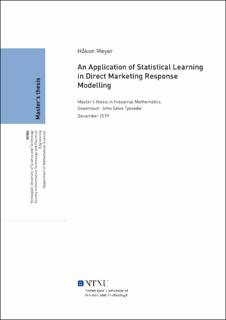| dc.contributor.advisor | John Sølve Tyssedal | |
| dc.contributor.author | Håkon Meyer | |
| dc.date.accessioned | 2020-06-04T16:02:25Z | |
| dc.date.available | 2020-06-04T16:02:25Z | |
| dc.date.issued | 2019 | |
| dc.identifier.uri | https://hdl.handle.net/11250/2656713 | |
| dc.description.abstract | Direkte markedsføring gir selskap en direkte form for kommunikasjon med deres kunder. For a ̊ oppna ̊ den ønskede responsen, er det viktig a ̊ velge en passende ma ̊lgruppe, der- for er responsmodellering en viktig komponent i direkte markedsføring. Med mengden data som samles, samt det store utvalget av modelleringsmetoder, kan en oppdage nye og meningsfulle sammenhenger mellom responsen og forklaringsvariablene.
Grunnlaget for denne oppgaven er data fra en markedsføringskampanje utført av Spare- bank 1 SMN, der deres kunder ble tilbudt kredittøkninger pa ̊ deres kredittkort. Dataene, samlet fra kampanjer utført mellom mars 2015 og januar 2019, inneholder persondata, kontodata og data knyttet til forbruk og transaksjoner.
Istedenfor a ̊ utføre en bineær klassifisering av individene, er tre modeller brukt for a ̊ rangere individer etter deres estimerte villighet til a ̊ respondere. Logit-modellen, random forests og gradient boosting machines ble brukt for a ̊ estimere sannsynlighet for respons, som kan brukes for a ̊ produsere den ønskede rangering.
Denne oppgaven har som ma ̊l a ̊ bidra ved a ̊ utforske hvordan statistiske metoder og modeller kan justeres og modifiseres for a ̊ forbedre modellenes prediksjonsevner, samt ved a ̊ utforske modellenes verktøy for a ̊ forsta ̊ sammenhenger mellom responsen og fork- laringsvariablene bedre. | |
| dc.description.abstract | Direct marketing offers a direct means of communication between companies and prospec- tive customers. Selecting the right target group is crucial in order to obtain the desired re- sponse, therefore response modelling is a key component in direct marketing endeavours.
With the amount of data collected and the wide variety of possible modelling methods, one can find novel and meaningful connections between the response and the explanatory variables.
The basis for this thesis is the data from a marketing campaign conducted by Spare- bank1 SMN, where their clients were offered credit increases on their credit cards. The data, collected from the campaign periods stretching from March of 2015 to January of 2019, includes personal data, account data and data on spending and transactions.
Rather than performing a binary classification of the individuals, the three models em- ployed in this thesis are used to produce a ranking of the individuals according to their willingness to respond. The estimated probability of response is ordered to produce a ranking of the individuals. The logit model, random forests and gradient boosting ma- chines were used to estimate the probability of response.
This thesis aims to contribute by exploring how statistical learning methods can be tuned or modified to increase predictive performance, and by exploring the model’s inter- pretation tools to better understand the relation between the explanatory variables and the response. | |
| dc.language | eng | |
| dc.publisher | NTNU | |
| dc.title | An Application of Statistical Learning in Direct Marketing Response Modelling | |
| dc.type | Master thesis | |
